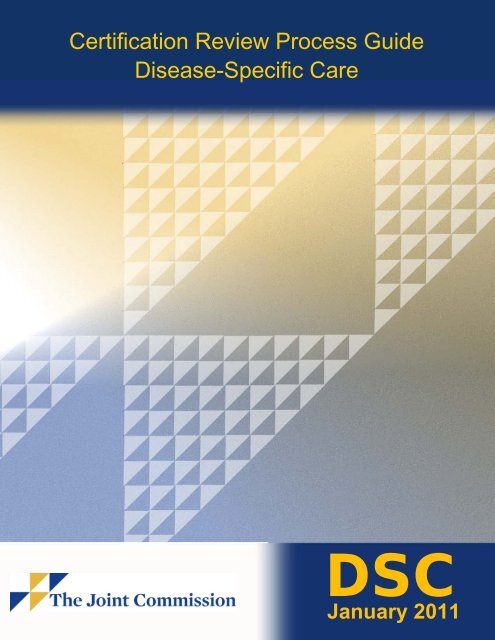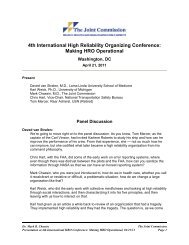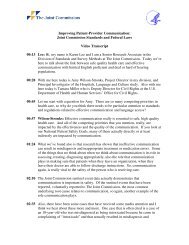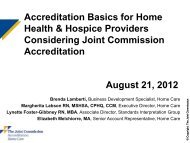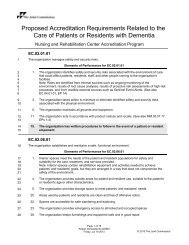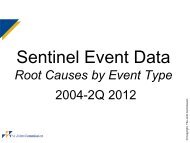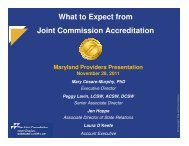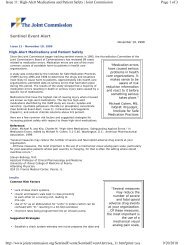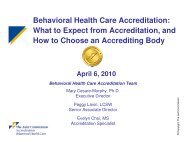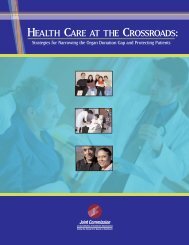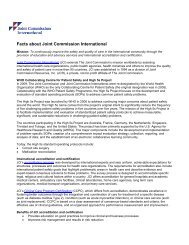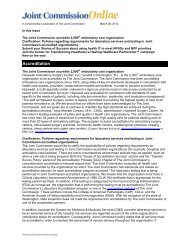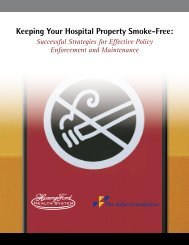Certification Review Process Guide Disease ... - Joint Commission
Certification Review Process Guide Disease ... - Joint Commission
Certification Review Process Guide Disease ... - Joint Commission
Create successful ePaper yourself
Turn your PDF publications into a flip-book with our unique Google optimized e-Paper software.
<strong>Certification</strong> <strong>Review</strong> <strong>Process</strong> <strong>Guide</strong><br />
<strong>Disease</strong>-Specific Care<br />
DSC<br />
January 2011
What's New in 2011<br />
Organization <strong>Review</strong> Preparation:<br />
Under the section titled "Logistics" organizations are advised that the reviewer<br />
will need access to the internet.<br />
Under the section titled "Items Required for <strong>Review</strong>er Planning Session," a note<br />
is included requesting that all patient lists include the following: Primary<br />
diagnosis, admission date, discharge date, patient age, gender, and if available,<br />
patient ethnicity. Also under this section, order sets, clinical pathways, protocols,<br />
etc., used to implement selected clinical practice guidelines are being requested.<br />
<strong>Review</strong>er Planning:<br />
A note has been added under the section titled "Materials Needed for this<br />
Session," requesting that all patient lists include the following: Primary diagnosis,<br />
admission date, discharge date, patient age, gender, and if available, patient<br />
ethnicity.<br />
<br />
Additionally under this section, order sets, clinical pathways, protocols, etc., that<br />
are used to implement selected clinical practice guidelines are being requested.<br />
System Tracer – Data Use: Under the Overview section, a discussion topic has been<br />
added related to the program's use of patient satisfaction and perception of care data in<br />
decision-making.<br />
Issue Resolution: Added a statement indicating that this session occurs only when<br />
necessary. If the reviewer has no issues to resolve or more information to review, he or<br />
she will proceed with Report Preparation activity.<br />
Appendix C – <strong>Certification</strong> <strong>Review</strong> Agenda Templates:<br />
The One <strong>Disease</strong>, One Day <strong>Review</strong> agenda template now includes activity<br />
descriptions and suggested organization participants.<br />
The applicability of the template agenda for Hip and Knee <strong>Joint</strong> Replacement<br />
Programs has been expanded to cover any two joint replacement (hip, knee,<br />
shoulder) programs and any two spine surgery (spinal fusion, laminectomy,<br />
discectomy) programs.
The <strong>Joint</strong> <strong>Commission</strong> <strong>Disease</strong> Specific Care <strong>Certification</strong> <strong>Review</strong> <strong>Process</strong> <strong>Guide</strong> 2011 Page 2 of 36
<strong>Disease</strong> Specific Care<br />
<strong>Certification</strong> <strong>Review</strong> <strong>Process</strong> <strong>Guide</strong><br />
Organization <strong>Review</strong> Preparation .......................................................................... 5<br />
Opening Conference and Orientation to Program ................................................. 9<br />
<strong>Review</strong>er Planning Session ................................................................................. 10<br />
Individual Tracer Activity ..................................................................................... 12<br />
System Tracer – Data Use .................................................................................. 15<br />
Competence Assessment & Credentialing <strong>Process</strong> ............................................ 17<br />
Issue Resolution .................................................................................................. 18<br />
<strong>Review</strong>er Report Preparation .............................................................................. 20<br />
Program Exit Conference .................................................................................... 21<br />
Intra-cycle Evaluation <strong>Process</strong> ............................................................................ 22<br />
Appendix A: Clinical Record <strong>Review</strong> Tool .......................................................... 24<br />
Appendix B: Human Resource Record <strong>Review</strong> Tool .......................................... 25<br />
Appendix C: <strong>Certification</strong> <strong>Review</strong> Agenda Templates ........................................ 26<br />
The <strong>Joint</strong> <strong>Commission</strong> <strong>Disease</strong> Specific Care <strong>Certification</strong> <strong>Review</strong> <strong>Process</strong> <strong>Guide</strong> 2011 Page 3 of 36
The <strong>Joint</strong> <strong>Commission</strong> <strong>Disease</strong> Specific Care <strong>Certification</strong> <strong>Review</strong> <strong>Process</strong> <strong>Guide</strong> 2011 Page 4 of 36
<strong>Disease</strong> Specific Care <strong>Certification</strong><br />
Organization <strong>Review</strong> Preparation<br />
The purpose of this activity guide is to inform organizations about how to prepare for the<br />
<strong>Disease</strong> Specific Care onsite certification review, including:<br />
Identifying ways in which the organization can facilitate the onsite review process<br />
Describing logistical needs for the onsite review<br />
Important Reading<br />
The <strong>Certification</strong> <strong>Review</strong> <strong>Process</strong> <strong>Guide</strong> describes each activity of a <strong>Joint</strong> <strong>Commission</strong> onsite<br />
certification review. Organizations should read through each of the following activity<br />
descriptions, which include:<br />
<br />
<br />
<br />
<br />
<br />
The purpose of the activity<br />
Descriptions of what will happen during the session<br />
Discussion topics, if applicable<br />
Recommended participants<br />
Any materials required for the session<br />
These descriptions can be shared organization-wide as appropriate.<br />
Pre-<strong>Review</strong> Phone Call<br />
A <strong>Joint</strong> <strong>Commission</strong> account executive will contact your organization by phone shortly after<br />
receiving your application for certification. The purpose of this call is to:<br />
Confirm information reported in the application for certification, to verify travel planning<br />
information and directions to office(s) and facilities,<br />
Confirm your access to The <strong>Joint</strong> <strong>Commission</strong> Connect extranet site and the<br />
certification-related information available there (onsite visit agenda, <strong>Certification</strong> <strong>Review</strong><br />
<strong>Process</strong> <strong>Guide</strong>, etc.), and<br />
Answer any organization questions and address any concerns.<br />
Notice of Initial <strong>Certification</strong> Onsite <strong>Review</strong><br />
If this is your program’s first time through the certification process you will receive at least a 30-<br />
day advance notice of your onsite review date(s). The Notification of Scheduled Events link on<br />
your organization’s extranet site, The <strong>Joint</strong> <strong>Commission</strong> Connect, is populated with the review<br />
date, reviewer’s name, biographical sketch and picture 30 days prior to the review date. The<br />
account executive can answer questions about the process or put you in contact with other <strong>Joint</strong><br />
<strong>Commission</strong> staff that can assist you.<br />
Notice of Re-<strong>Certification</strong> Onsite <strong>Review</strong><br />
Your organization will receive notice from The <strong>Joint</strong> <strong>Commission</strong> seven business days prior to<br />
the first day of the scheduled review date(s) for <strong>Disease</strong> Specific Care re-certification. The<br />
notice will be to the certification contact identified in your application and will include the specific<br />
review date(s) and the name of the reviewer. A follow-up communication with your organization<br />
will confirm the information previously provided. Additionally, the Notification of Scheduled<br />
Events link on your organization’s extranet site, The <strong>Joint</strong> <strong>Commission</strong> Connect, is populated<br />
The <strong>Joint</strong> <strong>Commission</strong> <strong>Disease</strong> Specific Care <strong>Certification</strong> <strong>Review</strong> <strong>Process</strong> <strong>Guide</strong> 2011 Page 5 of 36
with the review date, reviewer’s name, biographical sketch and picture at 7:00 a.m. in your local<br />
time zone on the morning of the review.<br />
Logistics<br />
While onsite, the reviewer(s) will need workspace for the duration of the visit. A desk or<br />
table, telephone, access to an electrical outlet and the internet are desirable.<br />
<br />
<br />
<br />
<br />
Some review activities will require a room or area that will accommodate a group of<br />
participants. Group activity participants should be limited, if possible, to key individuals that<br />
can provide insight on the topic of discussion. Participant selection is left to the<br />
organization’s discretion; however, this guide does offer suggestions.<br />
The reviewer will want to move throughout the facility or offices during Tracer Activity, talking<br />
with staff and observing the day-to-day operations of the organization along the way. The<br />
reviewer will rely on organization staff to find locations where discussions can take place<br />
that allow confidentiality and privacy to be maintained and that will minimize disruption to the<br />
area being visited.<br />
While reviewers will focus on current patients being cared for by the program, they may<br />
request to see some closed records as well in order to verify performance with guidelines<br />
such as those that address patient discharge and post discharge follow-up.<br />
Your onsite review agenda template, similar to those presented later in this guide, will be<br />
posted to your <strong>Joint</strong> <strong>Commission</strong> Connect extranet site. The review agenda presents a<br />
suggested order and duration of activities. Discuss with the reviewer any changes to the<br />
agenda that may be needed at any time during the onsite visit.<br />
Information Evaluated Prior to the Onsite <strong>Certification</strong> <strong>Review</strong><br />
The <strong>Joint</strong> <strong>Commission</strong> <strong>Certification</strong> <strong>Review</strong>er assigned to perform your organization’s onsite<br />
visit will receive the following items presented with your organization’s Request for <strong>Certification</strong>.<br />
1. Demographic information, including identification of the disease-specific care service(s)<br />
undergoing certification review<br />
2. A summary of the clinical practice guidelines used for each disease program seeking<br />
certification<br />
3. Stage I- Four non-standardized performance measures, including at least (2) clinicallyfocused<br />
measures; or Stage II – Standardized performance measures as defined by<br />
disease program<br />
On Re-certification reviews, the reviewer will also receive measure-related data<br />
submitted by the program<br />
4. Performance improvement plan<br />
The <strong>Joint</strong> <strong>Commission</strong> <strong>Disease</strong> Specific Care <strong>Certification</strong> <strong>Review</strong> <strong>Process</strong> <strong>Guide</strong> 2011 Page 6 of 36
Familiarizing a reviewer with your program before the onsite visit facilitates evaluation of your<br />
program’s compliance with standards. Advance analysis makes the on-site review time more<br />
efficient, effective and focused.<br />
Information Needed During Onsite <strong>Review</strong><br />
Please note that it is not necessary to prepare documentation just for purposes of the<br />
certification review. The reviewer is interested in seeing the resources that staff reference in<br />
their day-to-day activity. These items need not be stand-alone documents; the items noted may<br />
represent sections contained within other documents.<br />
Items Required for <strong>Review</strong>er Planning Session<br />
The following is a list of items that reviewers WILL NEED to see during the <strong>Review</strong>er Planning<br />
Session of the onsite review.<br />
<br />
Current list of patients being treated through the disease program<br />
(NOTE: It is desirable to have the following information included in both the list of current<br />
and discharged patients: Primary diagnosis, admit date, discharge date, patient age,<br />
gender and ethnicity, if available.)<br />
<br />
<br />
<br />
<br />
<br />
<br />
A list of patients who accessed or progressed through the disease program in the<br />
• past four months for initial reviews and<br />
• past twelve months for recertification reviews<br />
(NOTE: The above noted time frames can extend further back in order to increase the<br />
number of patients from which the reviewer can sample. Ten patients to select from is<br />
desired, but a lower number is acceptable in those programs that do not yet have<br />
experience with this number of patients)<br />
Order sets, clinical pathways, protocols, etc., that are used to implement selected clinical<br />
practice guidelines<br />
Performance measure data collected and reported for the required four measures<br />
Continuous quality improvement reports (for previous 12-months for re-certification reviews)<br />
Performance improvement action plans that demonstrate how data have been used to<br />
improve program care and services, when available<br />
An organization chart for the program, if one is available<br />
Additional Items Required for Primary Stroke Center <strong>Certification</strong> <strong>Review</strong>s<br />
In addition to the items noted above, the following documents WILL BE NEEDED for the<br />
<strong>Review</strong>er Planning Session:<br />
List of patients for the past four months with Ischemic Stroke<br />
<br />
<br />
<br />
List of patients who received tPA within the past four months<br />
List of patients for the past four months with Hemorrhagic Stroke<br />
List of patients for the past four months with TIA’s<br />
The <strong>Joint</strong> <strong>Commission</strong> <strong>Disease</strong> Specific Care <strong>Certification</strong> <strong>Review</strong> <strong>Process</strong> <strong>Guide</strong> 2011 Page 7 of 36
(NOTE: The above noted time frames can extend further back in order to increase the<br />
number of patients from which the reviewer can sample. Ten patients to select from is<br />
desired, but a lower number is acceptable in those programs that do not yet have<br />
experience with this number of patients)<br />
List of stroke team members<br />
Items <strong>Review</strong>ers May Request During Onsite <strong>Review</strong><br />
Following is a list of items that reviewers MAY REQUEST to see during any onsite review.<br />
<strong>Disease</strong> management program-specific policies and procedures<br />
Staff orientation materials, with target audience identified<br />
Staff job descriptions<br />
Program specific physician credentials requirements, if applicable<br />
Written criteria for appointing or hiring practitioners<br />
In-service or conference calendars and attendance sheets for the past 12 months and for<br />
remainder of current year or next six months<br />
Policies and procedures for education and competency training<br />
Frequently used internal forms or documents related to the clinical practice guidelines (for<br />
example, assessment, intervention, additional algorithms)<br />
Performance improvement policies and procedures<br />
Policies and procedures for collecting, processing, and analyzing data<br />
A list of data elements collected for selected program performance measures, and other<br />
data collection instructions or documents<br />
List of current and past purchasers of services; reviewers may contact purchasers (Applies<br />
to disease management companies only)<br />
Schedules and agendas of any classes, group meetings, seminars, etc. related to<br />
participant education<br />
Documents sent to participants about accessing the program’s services, when applicable<br />
<strong>Disease</strong> management program enrollment/participation requirements<br />
Any required business licenses<br />
Supporting policies and procedures related to ethical business and professional behavior<br />
Policies and procedures for identifying and managing unanticipated adverse events<br />
Policies and procedures for participant confidentiality<br />
Policies about retention of health records and other data and information<br />
Enrollment requirements, if applicable<br />
Who to Call with Questions<br />
Questions about standards and elements of performance – Call the Standards Interpretation<br />
Group at 630/792-5900. For a response by email, complete the “Standards Online Question<br />
Submission Form” by visiting www.jointcommission.org and selecting “Standards FAQs” under<br />
“TOP SPOTS.”<br />
Questions about onsite review process, agenda, scheduling, or other questions – Call your <strong>Joint</strong><br />
<strong>Commission</strong> Account executive.<br />
The <strong>Joint</strong> <strong>Commission</strong> <strong>Disease</strong> Specific Care <strong>Certification</strong> <strong>Review</strong> <strong>Process</strong> <strong>Guide</strong> 2011 Page 8 of 36
<strong>Disease</strong> Specific Care <strong>Certification</strong><br />
Opening Conference and Orientation to Program<br />
This session combines two activities into one 60-minute block of time. The breakdown of<br />
activities and suggested length for each follows.<br />
Organization Participants<br />
Opening Conference – Program(s) administrative and clinical leadership and others at the<br />
discretion of the organization<br />
Orientation to Organization – Program(s) administrative and clinical leadership and others at<br />
the discretion of the organization<br />
Materials Needed for this Session<br />
Organization chart, if applicable<br />
<strong>Disease</strong> Management Program organization chart, if applicable<br />
Overview of the Opening Conference (15 minutes)<br />
Approximately 15-minutes in duration that includes:<br />
<strong>Review</strong>er introduction<br />
Introduction of organization review coordinator and leaders (Please note: Other staff can be<br />
introduced as the reviewer encounters them throughout the onsite visit);<br />
Overview of The <strong>Joint</strong> <strong>Commission</strong> and <strong>Disease</strong> Specific Care <strong>Certification</strong><br />
Agenda review with discussion of any needed changes<br />
Questions and answers about the onsite review process.<br />
Overview of the Orientation to the Program (45 minutes)<br />
This 45-minute session is an exchange between the organization and reviewer about the<br />
disease management program(s) structure and scope of care and services. A brief,<br />
approximately 15-20 minute, summary presentation about the program is very helpful to the<br />
reviewer and often to organization staff participating in the review process. Additional<br />
discussion with the reviewer following the presentation will help clarify the documentation<br />
submitted by the program with their application for certification. The reviewer will facilitate the<br />
discussion and use the information as a base to build on while continuing their program review<br />
in other activities.<br />
Program representatives participating in this session should be able to discuss topics such as:<br />
Program mission, goals and objectives<br />
Program structure<br />
Program leadership and management<br />
Program design<br />
Program team composition<br />
Developing, implementing and evaluating the program<br />
Target population for the program<br />
Identified needs of the program population<br />
The selection and implementation of clinical practice guidelines<br />
Evaluation of clinical practice guideline use and appropriateness to target population<br />
Performance improvement process, including evaluation of the disease management<br />
program’s efficacy<br />
The <strong>Joint</strong> <strong>Commission</strong> <strong>Disease</strong> Specific Care <strong>Certification</strong> <strong>Review</strong> <strong>Process</strong> <strong>Guide</strong> 2011 Page 9 of 36
<strong>Disease</strong> Specific Care <strong>Certification</strong><br />
<strong>Review</strong>er Planning Session<br />
During this session, the reviewer(s), in conjunction with disease management program<br />
representatives, will identify the patients or program participants that they would like to follow<br />
during tracer activity. Additionally, reviewers will identify personnel and credentials files that<br />
they will need for review during the Competence Assessment and Credentialing <strong>Process</strong><br />
session. If the program works with purchasers, the reviewer will also want to select and<br />
schedule phone calls with one or more purchasers that have used the program’s services.<br />
Organization Participants<br />
Program representative(s) that will facilitate tracer activity<br />
Individual(s) responsible for obtaining clinical records<br />
Materials Needed for this Session<br />
Current list of patients being treated through the disease program<br />
<br />
<br />
<br />
If there are no patients currently being treated, a list of patients who accessed or progressed<br />
through the disease program in the past 4-12 months<br />
(NOTE: It is desirable to have the following information included in both the list of current<br />
and discharged patients: Primary diagnosis, admit date, discharge date, patient age,<br />
gender and ethnic origin, if available.)<br />
Order sets, clinical pathways, protocols, etc., that are used to implement selected clinical<br />
practice guidelines<br />
List of current and past purchasers (applies to disease management companies only)<br />
In addition to the items noted above, the following documents will be needed for the <strong>Review</strong>er<br />
Planning Session for Primary Stroke Center <strong>Certification</strong> reviews:<br />
<br />
<br />
<br />
<br />
<br />
List of patients for the past 4-12 months with Ischemic Stroke<br />
List of patients who received tPA within the past 4-12 months<br />
List of patients for the past 4-12 months with Hemorrhagic Stroke<br />
List of patients for the past 4-12 months with TIA’s<br />
List of stroke team members<br />
Planning <strong>Guide</strong>lines – Selecting Patients to Trace<br />
1. <strong>Review</strong>ers will describe to the program representatives the types of patients that they want<br />
to trace and request their assistance in identifying individuals who may fit the description. A<br />
list of active patients is needed for this activity, or the reviewer may proceed directly to a<br />
patient care area and ask the staff to help identify patients.<br />
2. A minimum of five (5) patients will be selected<br />
Patients selected should present the opportunity to trace care and services through as<br />
many of the potential departments, areas, sites, or services that support or participate<br />
directly in the disease specific care program.<br />
The <strong>Joint</strong> <strong>Commission</strong> <strong>Disease</strong> Specific Care <strong>Certification</strong> <strong>Review</strong> <strong>Process</strong> <strong>Guide</strong> 2011 Page 10 of 36
Patients should have different characteristics, such as demographics, age, sex and other<br />
factors that would influence the program response, or impact the application of clinical<br />
practice guidelines.<br />
For Primary Stroke Programs ONLY—In addition to the above guidelines for patient<br />
tracer selection, within the five (5) patients selected the reviewer will want to include<br />
patients who experienced TIA, thrombosis or embolus, patients treated with intravenous<br />
tPA for a stroke, and patients who experienced a hemorrhagic stroke.<br />
3. <strong>Review</strong>ers will prioritize patients for tracer activity with the organization’s assistance.<br />
Planning <strong>Guide</strong>lines – Selecting Competence and Credentials Files for <strong>Review</strong><br />
1. A minimum of (5) files will be selected per disease management program<br />
2. At least one file per discipline (physician, nurse, social worker, dietitian, therapist, etc.)<br />
represented on the disease management program team will be reviewed.<br />
3. The reviewer will select these files based on the individuals encountered during tracer<br />
activity, that is, those caring for or who cared for the patient being traced. Please let the<br />
reviewer know if there could be a delay in getting files for review.<br />
Planning <strong>Guide</strong>lines – Contact with Discharged Patients<br />
<strong>Review</strong>ers will want to have some contact with the program’s patients. If there are no active<br />
patients at the time of the review, the reviewer will request the program representatives to<br />
arrange for a phone call with one or more past participants.<br />
Planning <strong>Guide</strong>lines – Contact with Purchasers<br />
If the disease management program provides services through purchasers, the reviewer would<br />
like the opportunity to speak with at least one of the current purchasers using the program’s<br />
services. Program representatives will be asked to make arrangements for this contact.<br />
The <strong>Joint</strong> <strong>Commission</strong> <strong>Disease</strong> Specific Care <strong>Certification</strong> <strong>Review</strong> <strong>Process</strong> <strong>Guide</strong> 2011 Page 11 of 36
<strong>Disease</strong> Specific Care <strong>Certification</strong><br />
Individual Tracer Activity<br />
The individual tracer activity is a review method used to evaluate an organization’s provision of<br />
care, treatment and services using the patient’s experience as the guide. During an individual<br />
tracer the reviewer(s) will:<br />
Follow a patient’s course of care, treatment or service through the program<br />
Assess the impact of interrelationships among the program disciplines on patient care<br />
Assess the use of and adherence and diversion from clinical guidelines in the patient’s<br />
care, treatment or service<br />
Evaluate the integration and coordination of program and organization services in the<br />
patient’s care<br />
Organization Participants<br />
Program staff and other organization staff who have been involved in the patient’s care,<br />
treatment or services<br />
Materials Needed for this Session<br />
Clinical records of selected patients<br />
Overview of the Individual Tracer Activity<br />
1. A significant portion of the agenda is designated for patient tracer activity. The number of<br />
patients traced during this time will vary. NOTE: In-house patients take priority for tracer<br />
activity; however, there may be instances when reviewers will select a discharged patient<br />
upon which to conduct a tracer. This will occur when reviewers need to trace the care<br />
provided to a patient with a given diagnosis, for example patients experiencing an ischemic<br />
stroke or a TIA. This may also occur to evaluate the patient discharge/education process for<br />
a program.<br />
2. Tracer activity begins in the unit, clinic or outpatient setting in which the patient may be<br />
scheduled for visit or where the patient is routinely receiving care, treatment and services, or<br />
in the case of a discharged patient, the location from which they were discharged.<br />
3. The organization/program staff and the <strong>Joint</strong> <strong>Commission</strong> certification reviewer will use the<br />
patient’s record to discuss and map out the patient’s course of care, treatment and services.<br />
The number of staff participating in this stage of the tracer should be limited.<br />
4. Organization/program staff and the reviewer will follow their map, moving through the<br />
organization, as appropriate, visiting and speaking with staff in all the areas, programs, and<br />
services involved in the patient’s encounter. There is no mandated order for visits to these<br />
other areas. <strong>Review</strong>ers will speak with any staff available in the area. NOTE: This activity<br />
will occur on in-house as well as discharged patients.<br />
5. Throughout tracer activity, reviewers<br />
Observe program staff and patient interaction<br />
Observe the care planning process<br />
Observe medication processes, if applicable<br />
Consider the impact of the environment on individual safety and staff roles in minimizing<br />
environmental risk<br />
Speak with staff about the care, treatment and services they provide<br />
The <strong>Joint</strong> <strong>Commission</strong> <strong>Disease</strong> Specific Care <strong>Certification</strong> <strong>Review</strong> <strong>Process</strong> <strong>Guide</strong> 2011 Page 12 of 36
Speak with patients or families, if appropriate and permission is granted by the patient or<br />
family. Discussion will focus on the course of care and other aspects of the program(s)<br />
being evaluated for certification. NOTE: If the patient being traced is already<br />
discharged, the reviewer may ask the program to see if a phone call with the<br />
patient/family is feasible and can be arranged.<br />
Look at procedures or other documents, as needed to verify processes or to further<br />
answer questions that still exist after staff discussions.<br />
The tracer should lead the reviewer back to the starting point of care. Upon returning, the<br />
reviewer will follow-up on observations made either through additional record review or<br />
discussions with staff.<br />
At the conclusion of the tracer, the reviewer communicates to the program leaders and care<br />
providers any:<br />
Specific observations made<br />
Issues that will continue to be explored in other tracer activity,<br />
Need for additional record review, and<br />
Issues that have the potential to result in requirements for Improvement.<br />
Individual Tracer in the Clinical Setting<br />
Includes the following activities:<br />
Record review with staff<br />
Trace a patient’s care and services from preadmission through post-discharge, as<br />
applicable to disease management program being certified<br />
Visit units, departments, programs and services involved in the patient’s care<br />
Observe environment of care<br />
Observe the delivery of care and services<br />
Observe staff interaction with patients<br />
Speak with representatives of disciplines involved in patient’s care, preferably with staff who<br />
interacted with the patient if available<br />
Interview patient and/or family member, in person or by phone<br />
Trace disease management post-acute care support programs including:<br />
• the scheduling of follow-up laboratory, clinic, or therapy appointments, home visits,<br />
patient self-monitoring and electronic reporting (e.g., blood glucose levels, blood<br />
pressure)<br />
• <strong>Review</strong> of records and logs the organization maintains on either direct contact with<br />
patients or on contact with clinical customers<br />
Individual Tracer Activity when DSC Services Delivered Remotely<br />
Includes the following activities:<br />
Record review with staff<br />
Trace a patient’s care and services from preadmission through post-discharge, as<br />
applicable to disease program being certified<br />
Observe staff interaction with patients<br />
Speak with representatives of disciplines involved in patient’s care, preferably with staff who<br />
interacted with the patient if available<br />
Interview patient and/or family member, in person or by phone<br />
Trace services provided to clinical settings based on contractual agreements<br />
Trace disease management post-acute care support programs including:<br />
The <strong>Joint</strong> <strong>Commission</strong> <strong>Disease</strong> Specific Care <strong>Certification</strong> <strong>Review</strong> <strong>Process</strong> <strong>Guide</strong> 2011 Page 13 of 36
• the scheduling of follow-up laboratory, clinic, or therapy appointments, home visits,<br />
patient self-monitoring and electronic reporting (e.g., blood glucose levels, blood<br />
pressure)<br />
<strong>Review</strong> of records and logs the organization maintains on either direct contact with patients<br />
or on contact with clinical customers<br />
The <strong>Joint</strong> <strong>Commission</strong> <strong>Disease</strong> Specific Care <strong>Certification</strong> <strong>Review</strong> <strong>Process</strong> <strong>Guide</strong> 2011 Page 14 of 36
<strong>Disease</strong> Specific Care <strong>Certification</strong><br />
System Tracer- Data Use<br />
This session is focused on the program’s use of data in improving safety and quality of care for<br />
their patients. The reviewer and the organization will:<br />
Identify strengths and weaknesses in the organization’s use of data, areas for<br />
improvement, and any actions taken or planned to improve performance.<br />
Identify specific data use issues requiring further exploration as part of subsequent<br />
review activities.<br />
Organization Participants<br />
Program administrative and clinical leaders<br />
Others at the discretion of the organization<br />
Materials Needed for this Session<br />
Performance measure data reports<br />
Action plans demonstrating the program’s use of and response to data<br />
Overview of the Data Use System Tracer<br />
During the session, the reviewer(s) and organization will discuss:<br />
<br />
<br />
<br />
<br />
<br />
<br />
The basics of data gathering and preparation, including:<br />
• Selection of performance measures<br />
• Data collection, including validity and reliability<br />
• Data analysis and interpretation<br />
• Dissemination /transmission<br />
• Data use and actions taken on opportunities for improvement<br />
• Monitoring performance/improvement<br />
The performance measures selected to evaluate the processes and outcomes specific to<br />
the program, including how the selections were made (committee consensus, clinical<br />
staff voting, etc.) and measure implementation<br />
How clinical and management data is used in decision-making and in improving the<br />
quality of care and patient safety<br />
How patient satisfaction and perception of care data is used in decision-making and<br />
improving quality of care and patient safety<br />
Strengths and weaknesses in the processes used to obtain data and meet internal and<br />
external information needs.<br />
Techniques used to protect confidentiality and security of all types of patient data.<br />
Use of data for all aspects of the program, including medication management and infection<br />
control, as applicable, should be discussed during this session.<br />
The reviewer(s) will want to know about the program’s priorities for performance improvement<br />
activities and how these fit into the organization’s overall performance improvement processes.<br />
This discussion may include a review of:<br />
<br />
Actions taken as a result of using data<br />
The <strong>Joint</strong> <strong>Commission</strong> <strong>Disease</strong> Specific Care <strong>Certification</strong> <strong>Review</strong> <strong>Process</strong> <strong>Guide</strong> 2011 Page 15 of 36
Selection and prioritization of performance improvement activities<br />
Dissemination of findings and staff involvement<br />
Data reporting – when it occurs and to whom<br />
Type of analyses being conducted – approach to trending data over time, comparing<br />
data to an expected level of performance, and looking at data in combination for<br />
potential cause and effect relationships.<br />
The <strong>Joint</strong> <strong>Commission</strong> <strong>Disease</strong> Specific Care <strong>Certification</strong> <strong>Review</strong> <strong>Process</strong> <strong>Guide</strong> 2011 Page 16 of 36
<strong>Disease</strong> Specific Care <strong>Certification</strong><br />
Competence Assessment & Credentialing <strong>Process</strong><br />
The purpose of this session is to discuss how the program meets the need for qualified and<br />
competent practitioners.<br />
Organization Participants<br />
Program leaders<br />
Clinical leaders<br />
Organization representatives responsible for human resources processes<br />
Organization representatives responsible for credentialing processes, if different from above<br />
Individuals with authorized access to, and familiar with the format of files<br />
Others at the discretion of the organization<br />
Materials Needed for this Session<br />
Personnel or credentials files for individuals identified by the reviewer<br />
<br />
<br />
A minimum of five (5) files will be selected<br />
At least one file per discipline (physician, nurse, social work, dietician, therapist, etc.)<br />
represented on the disease management program team will be reviewed<br />
Note: The reviewer will select these files based on the individuals encountered during tracer<br />
activity, that is, those caring for or who cared for the patient being traced. Please let the<br />
reviewer know if there could be a delay in getting files for review.<br />
Overview of the Competence Assessment and Credentialing <strong>Process</strong> Session<br />
During the session, the reviewer and organization representatives will:<br />
<br />
Discuss the following competence assessment and credentialing topics as they relate to the<br />
program seeking certification:<br />
• How the program fits into any organization-wide competence and credentialing<br />
processes, if applicable<br />
• Hiring criteria unique to the program<br />
• Selection of disease management team members<br />
• Program-specific competence and credentials requirements<br />
• <strong>Process</strong>es for obtaining team member credentials information<br />
• Program-specific credentials evaluation criteria<br />
• Orientation and training process for disease management program team<br />
• Methods for assessing competence of practitioners and team<br />
• Unique orientation, on-going education, training and in-service requirements for the<br />
program<br />
<br />
Participate in a facilitated review of selected files for:<br />
• Relevant education, experience and training or certification<br />
The <strong>Joint</strong> <strong>Commission</strong> <strong>Disease</strong> Specific Care <strong>Certification</strong> <strong>Review</strong> <strong>Process</strong> <strong>Guide</strong> 2011 Page 17 of 36
• Current licensure-that has been verified through the primary source<br />
• Competence<br />
• Evidence reflecting completion of any required continuing education<br />
Individuals attending this session should be prepared to explain the program’s approach to<br />
credentialing and competency assessment. Additionally, the organization should be prepared to<br />
address any program-specific credentials and competence requirements if this is certification for<br />
an advanced disease management program. These requirements exist for:<br />
• Primary Stroke Centers<br />
• Lung Volume Reduction Surgery<br />
• Ventricular Assist Device<br />
• Management of Patients with Diabetes in the Inpatient Setting<br />
• Chronic Kidney <strong>Disease</strong><br />
These advanced program requirements can be identified in the 2011 <strong>Disease</strong> Specific Care<br />
<strong>Certification</strong> standards manual.<br />
The <strong>Joint</strong> <strong>Commission</strong> <strong>Disease</strong> Specific Care <strong>Certification</strong> <strong>Review</strong> <strong>Process</strong> <strong>Guide</strong> 2011 Page 18 of 36
<strong>Disease</strong> Specific Care <strong>Certification</strong><br />
Issue Resolution<br />
Issue resolution time is an opportunity for the reviewer to follow-up on potential findings that<br />
could not be resolved in other onsite activities. This is also time for the organization to present<br />
any information that they believe the reviewer may have missed during the day or that may not<br />
have been immediately available upon the reviewer’s request.<br />
Organization Participants<br />
Will vary depending upon the issue<br />
Materials Needed for this Session<br />
Will vary depending upon the issue<br />
Preparation for Issue Resolution<br />
None required<br />
Overview of the Issue Resolution Session<br />
The reviewer may have identified issues during individual tracer activity or other sessions that<br />
require further exploration or follow-up with staff. This follow-up may include a variety of<br />
activities such as:<br />
<br />
<br />
<br />
<br />
<strong>Review</strong> of policies and procedures<br />
<strong>Review</strong> of human resources files<br />
<strong>Review</strong> of performance improvement data<br />
Discussions with selected staff<br />
The reviewer will work with the program’s certification review coordinator to organize and<br />
conduct all issue resolution activity.<br />
If there are no issues to resolve and the reviewer does not need any additional information, this<br />
activity will not need to occur. The reviewer will proceed with Report Preparation activity.<br />
The <strong>Joint</strong> <strong>Commission</strong> <strong>Disease</strong> Specific Care <strong>Certification</strong> <strong>Review</strong> <strong>Process</strong> <strong>Guide</strong> 2011 Page 19 of 36
<strong>Disease</strong> Specific Care <strong>Certification</strong><br />
<strong>Review</strong>er Report Preparation<br />
The reviewer uses this time to compile, analyze and organize the data he or she has collected<br />
into a summary report of observations made throughout the review.<br />
Organization Participants<br />
None required, unless specifically requested by the reviewer<br />
Materials Needed for this Session<br />
Private work space with access to an electrical outlet and internet connection, if available<br />
Overview of the <strong>Review</strong>er Report Preparation Session<br />
The reviewer uses this time to enter their observations that reflect standards compliance issues.<br />
If organization interruptions can be kept to a minimum during this time, it will help the reviewer<br />
remain on schedule and deliver a report at the appointed time. The reviewer will be using their<br />
laptop computer to prepare the Summary of <strong>Certification</strong> <strong>Review</strong> Findings report and plan for<br />
the Exit Conference.<br />
The <strong>Joint</strong> <strong>Commission</strong> <strong>Disease</strong> Specific Care <strong>Certification</strong> <strong>Review</strong> <strong>Process</strong> <strong>Guide</strong> 2011 Page 20 of 36
<strong>Disease</strong> Specific Care <strong>Certification</strong><br />
Program Exit Conference<br />
The Program Exit Conference is the final onsite activity when the organization receives a<br />
preliminary report of findings from the reviewer. In addition, reviewers will<br />
Discuss any standards compliance issues<br />
Allow the organization a final onsite opportunity to question the review findings and provide<br />
additional material regarding standards’ compliance<br />
<strong>Review</strong> required follow-up actions as applicable<br />
Organization Participants<br />
Program leaders<br />
Clinical leaders<br />
Other staff at the discretion of the organization<br />
Materials Needed for this Session<br />
Copies of the Summary of <strong>Certification</strong> <strong>Review</strong> Findings report—if it is being distributed to staff<br />
Preparation for the Program Exit Conference<br />
None required<br />
Overview of the Program Exit Conference<br />
This is a 30-minute activity that takes place at the completion of a program review.<br />
Administrative and clinical program leaders, and other organization staff, as invited, will hear a<br />
verbal report of observations made during the review. The Summary of <strong>Certification</strong> <strong>Review</strong><br />
Findings Report is shared with participants in the Exit Conference ONLY with the permission of<br />
the CEO. All reports left onsite are preliminary and subject to change upon review by <strong>Joint</strong><br />
<strong>Commission</strong> central office staff.<br />
NOTE: In those instances when more than one disease management program is being<br />
reviewed in a day, the reviewer(s) may coordinate with the organization to conduct a combined<br />
Program Exit Conference at the end of the day to discuss each program. Please inform the<br />
reviewer(s) during the Opening Conference if this arrangement is not agreeable to the<br />
organization.<br />
The <strong>Joint</strong> <strong>Commission</strong> <strong>Disease</strong> Specific Care <strong>Certification</strong> <strong>Review</strong> <strong>Process</strong> <strong>Guide</strong> 2011 Page 21 of 36
<strong>Disease</strong> Specific Care <strong>Certification</strong><br />
Intra-cycle Evaluation <strong>Process</strong><br />
All organizations participating in the certification process are required to collect, report, and<br />
monitor their performance relative to standardized and non-standardized measures on an<br />
ongoing basis. The <strong>Certification</strong> Measure Information <strong>Process</strong> (CMIP) tool assists certified<br />
organizations with the data collection, reporting and monitoring requirements associated with<br />
performance measures. The CMIP tool is available on your organization’s secure extranet site,<br />
The <strong>Joint</strong> <strong>Commission</strong> Connect. The Performance Measure (PM) Data Report portion of the<br />
CMIP tool is available for all <strong>Disease</strong> Specific Care programs to perform an annual analysis of<br />
their performance relative to each performance measure.<br />
A mid-point (intra-cycle) evaluation of the performance measurement activities and standards<br />
compliance will be conducted via conference call with a <strong>Joint</strong> <strong>Commission</strong> reviewer.<br />
Prior to the Intra-cycle Event<br />
Your organization will receive an automated email to the primary certification contact and the<br />
CEO approximately 90 days in advance of the anniversary date of your last certification review.<br />
You will have 30 days to enter any missing monthly data points for any of the performance<br />
measures, complete the performance measure (PM) data report for each measure, and review<br />
your performance improvement plan for any updates. Once everything has been entered or<br />
updated, please use the submission checklist section of the CMIP tool to formally submit the<br />
CMIP tool to The <strong>Joint</strong> <strong>Commission</strong> for the intra-cycle event. If the tool is not submitted on time,<br />
your organization will receive an email reminder to submit the tool or risk having your<br />
certification decision changed.<br />
Intra-cycle Evaluation Logistics<br />
This call will take place as close as possible to the one year mid-point of the current two year<br />
certification cycle. The call will be completed by a <strong>Joint</strong> <strong>Commission</strong> reviewer who will contact<br />
the person identified in the “Intra-cycle Conference Call Contact Information” section of the<br />
CMIP tool for a time that is convenient to both parties involved. Participation in the intra-cycle<br />
conference call is mandatory for all <strong>Disease</strong> Specific Care programs.<br />
Organization Participants<br />
Staff involved in data collection and analysis<br />
Program leaders that implement performance improvement plans<br />
Overview of the Intra-cycle Evaluation <strong>Process</strong><br />
During the conference call, the reviewer will discuss<br />
The results of your organization’s performance against the performance measures<br />
(monthly data),<br />
Your analysis of your performance (PM Data Report),<br />
Your organization’s ongoing approach to performance improvement (PI Plan), and<br />
Your questions regarding compliance with <strong>Joint</strong> <strong>Commission</strong> standards.<br />
This call is your organization’s opportunity to have an interactive discussion with the <strong>Joint</strong><br />
<strong>Commission</strong> reviewer to assure you are on the right track relative to performance measurement<br />
and ongoing performance improvement and standards compliance.<br />
The <strong>Joint</strong> <strong>Commission</strong> <strong>Disease</strong> Specific Care <strong>Certification</strong> <strong>Review</strong> <strong>Process</strong> <strong>Guide</strong> 2011 Page 22 of 36
There are no negative outcomes to the intra-cycle event, unless the reviewer identifies that your<br />
organization has not actively engaged in performance measurement and improvement activities<br />
since the time of the most recently completed initial or recertification review.<br />
Once the intra-cycle conference call has been completed, the reviewer will notify your assigned<br />
Account Executive of the successful completion of your organization's intra-cycle event. A letter<br />
of continuing certification is then posted to the correspondence section of your organization's<br />
secure extranet site.<br />
The <strong>Joint</strong> <strong>Commission</strong> <strong>Disease</strong> Specific Care <strong>Certification</strong> <strong>Review</strong> <strong>Process</strong> <strong>Guide</strong> 2011 Page 23 of 36
<strong>Disease</strong> Specific Care<br />
CLINICAL RECORD REVIEW TOOL<br />
Appendix A<br />
(Program use of this tool is optional)<br />
Areas of <strong>Review</strong> Standard Record Number<br />
1 2 3 4 5<br />
ITEMS FOR REVIEW<br />
1 There is a record for every participant DSCT.5<br />
2 The record contains sufficient information to identify the patient DSCT.5<br />
3 The record contains sufficient information to support the DSCT.5<br />
diagnosis<br />
4 The record contains sufficient information to justify treatment or DSCT.5<br />
services<br />
5 The record contains sufficient information to document the DSCT.5<br />
course and results of treatment or services<br />
6 The record contains sufficient information to track the patients DSCT.5<br />
movement through the care system and facilitate continuity of<br />
care both internally and externally to the program<br />
7 Records appear to be complete and accurate, with all<br />
DSCT.5<br />
necessary information available.<br />
8 Comments are added to records in accordance with<br />
DSCT.1<br />
organization policy or procedure<br />
9 Consent for release of information is on the record records in DSCT.1<br />
accordance with organization policy or procedure<br />
10 The use of CPGs is evident in the record DSDF.2<br />
11 The tailoring of CPGs for the participant is evident in the record DSDF.3<br />
12 The management or the communication to the appropriate DSDF.4<br />
practitioner for the management of concurrently occurring<br />
conditions for the participant is evident in the record<br />
13 The involvement of participant in making decisions about DSSE.1<br />
managing their disease or condition are evident in the record<br />
14 The involvement of support structures in the promotion of life DSSE.2<br />
style changes that support self-management regimens is<br />
evident in the record<br />
16 The participants response to making recommended life-style DSSE.2<br />
changes is evaluated<br />
17 An assessment of the participants educational needs related to DSSE.3<br />
life-style changes is evident in the record<br />
18 An assessment of the participants educational needs related to DSSE.3<br />
health promotion and disease prevention is evident in the<br />
record<br />
19 An assessment of the participants educational needs related to DSSE.3<br />
information about the participants illnesses and treatments is<br />
evident in the record<br />
20 An assessment of the participant’s comprehension of education DSSE.3<br />
is evaluated initially and on an on-going basis.<br />
21 When appropriate, there is evidence of the participant being<br />
notified about screening recommendations or life style changes<br />
related to preventing the disease for their family members<br />
DSSE.3<br />
The <strong>Joint</strong> <strong>Commission</strong> <strong>Disease</strong> Specific Care <strong>Certification</strong> <strong>Review</strong> <strong>Process</strong> <strong>Guide</strong> 2011 Page 24 of 36
<strong>Disease</strong> Specific Care<br />
HUMAN RESOURCE RECORD REVIEW TOOL<br />
(Program use of this tool is optional)<br />
Appendix B<br />
Areas of <strong>Review</strong> Standard Record Number<br />
ITEMS FOR REVIEW<br />
1 Practitioners have educational backgrounds, experience, DSDF.1<br />
training and/or certification consistent with the program’s<br />
mission, goals, and/or objectives<br />
2 All practitioners hired have a current license and<br />
DSDF.1<br />
competency is established.<br />
3 The competence of practitioners is assessed when new DSDF.1<br />
techniques or responsibilities are introduced, and<br />
periodically within the timeframes defined by the<br />
organization.<br />
4 All practitioners have current licenses DSDF.1<br />
5 Current licensure is verified from primary sources DSDF.1<br />
6 Although not required in the HR record, ascertain that DSDF.1<br />
orientation was conducted and relevant<br />
7 Although not required in the HR record, ascertain<br />
participation in continuing education<br />
DSDF.1<br />
1 2 3 4 5<br />
Please note: Some items can be located outside the human resources record.<br />
The <strong>Joint</strong> <strong>Commission</strong> <strong>Disease</strong> Specific Care <strong>Certification</strong> <strong>Review</strong> <strong>Process</strong> <strong>Guide</strong> 2011 Page 25 of 36
Appendix C – Onsite <strong>Review</strong> Agenda Templates<br />
Agenda Description<br />
Page<br />
One Day, One <strong>Review</strong>er, One <strong>Disease</strong> 27-28<br />
Two Days, One <strong>Review</strong>er, One <strong>Disease</strong> 29<br />
One Day, One <strong>Review</strong>er, Two <strong>Joint</strong> Replacement or Two Spine Surgery Programs 30-32<br />
1.5 Days, One <strong>Review</strong>er, Lung Volume Reduction Surgery Program 33-34<br />
1.5 Days, One <strong>Review</strong>er, Ventricular Assist Device Program 35-36<br />
The <strong>Joint</strong> <strong>Commission</strong> <strong>Disease</strong> Specific Care <strong>Certification</strong> <strong>Review</strong> <strong>Process</strong> <strong>Guide</strong> 2011 Page 26 of 36
<strong>Disease</strong> Specific Care <strong>Certification</strong><br />
One <strong>Disease</strong>, One Day <strong>Review</strong> Agenda Template<br />
Note: Please refer to the Organization <strong>Review</strong> Preparation section of this guide for materials that<br />
the reviewer needs for the Planning Session.<br />
Time <strong>Review</strong>er Organization Participants<br />
8:00 – 8:30 a.m.<br />
8:30 – 9:00 a.m.<br />
Opening Conference (10 minutes)<br />
• Greetings and introductions<br />
• Introductions of key program and<br />
organization staff<br />
• Brief review of agenda<br />
Program clinical and<br />
administrative leadership<br />
Orientation to Program (30 minutes)<br />
Topics to be covered include:<br />
• Program leadership<br />
• Program team composition<br />
• Program design and integration into<br />
hospital<br />
• Program mission and goals for care<br />
• Population characteristics and needs<br />
• Program selection and<br />
implementation of clinical practice<br />
guidelines (CPG)<br />
• Program evaluation of CPG use and<br />
deviation monitoring<br />
• Program improvements in CPG<br />
content and use<br />
• Overall program improvements<br />
implemented or planned<br />
Q & A Discussion (20 minutes)<br />
Individual(s) responsible for<br />
performance improvement<br />
processes within the<br />
program and, as applicable,<br />
the organization<br />
Others at the discretion of<br />
the organization<br />
9:00 – 9:30 a.m. <strong>Review</strong>er Planning Session Program representative(s)<br />
who can facilitate patient<br />
selection and tracer activity<br />
9:30 – 12:30 a.m. Individual Tracer Activity<br />
10:00 – 10:30 a.m.<br />
10:30 – 11:00 a.m. During this activity the reviewer will be<br />
11:00 – 11:30 a.m. moving throughout the organization and<br />
11:30 – 12:00 p.m. interacting with staff in areas that have been<br />
12:00 – 12:30 p.m. in contact with the patients selected for<br />
tracer activity. The reviewer will also want<br />
to speak with the patient or family of the<br />
patient with their permission.<br />
Program representative(s)<br />
who can facilitate tracer<br />
activity, that is, escort the<br />
reviewer through the clinical<br />
setting following the course<br />
of care for the patient<br />
12:30 – 1:00 p.m. <strong>Review</strong>er Lunch<br />
The <strong>Joint</strong> <strong>Commission</strong> <strong>Disease</strong> Specific Care <strong>Certification</strong> <strong>Review</strong> <strong>Process</strong> <strong>Guide</strong> 2011 Page 27 of 36
Time <strong>Review</strong>er Organization Participants<br />
1:00 – 1:30 p.m.<br />
1:30 – 2:00 pm.<br />
System Tracer – Data Use<br />
During this activity the discussion will focus<br />
on the program’s selected performance<br />
measures.<br />
Program clinical and<br />
administrative leadership<br />
Individual(s) responsible for<br />
performance improvement<br />
processes within the<br />
program and, as applicable,<br />
2:00 – 2:30 p.m. Competence Assessment/Credentialing<br />
2:30 – 3:00 p.m. <strong>Process</strong><br />
Discussion during this session will focus on:<br />
• Selection of disease management team<br />
members<br />
• <strong>Process</strong>es for obtaining team member<br />
credentials information<br />
• Orientation and training process for<br />
disease management program team<br />
• Methods for assessing competence of<br />
practitioners and team members<br />
• In-service and other education and<br />
training activities provided to program<br />
team members.<br />
the organization<br />
Individual with authorized<br />
access to personnel and<br />
credentials files<br />
Individual familiar with<br />
program-specific<br />
requirements for team<br />
members—supervisors,<br />
managers, leaders<br />
Clinical or medical director<br />
<strong>Review</strong>ers will request personnel records<br />
for review based on various team members<br />
and staff encountered or referred to<br />
throughout the day.<br />
3:00 – 3:30 p.m. Issue Resolution & <strong>Review</strong>er Report<br />
3:30 – 4:00 p.m. Preparation<br />
This time is reserved for the reviewer to<br />
finish reviewing any outstanding items and<br />
complete a report reflecting each program’s<br />
performance against the standards.<br />
4:00 – 4:30 p.m. Program Exit Conference<br />
<strong>Review</strong>er presentation of certification<br />
observations and requirements for<br />
improvement<br />
As requested by the<br />
reviewer:<br />
<strong>Certification</strong> review facilitator<br />
Program leaders and staff<br />
Program and clinical<br />
leadership<br />
Others at the discretion of<br />
the organization<br />
The <strong>Joint</strong> <strong>Commission</strong> <strong>Disease</strong> Specific Care <strong>Certification</strong> <strong>Review</strong> <strong>Process</strong> <strong>Guide</strong> 2011 Page 28 of 36
<strong>Disease</strong> Specific Care <strong>Certification</strong><br />
Two Day <strong>Review</strong> Agenda Template<br />
Note: Please refer to the Organization <strong>Review</strong> Preparation section of this guide for materials that<br />
the reviewer needs for the Planning Session.<br />
First Day<br />
Time <strong>Review</strong>er Organization Participants<br />
8:00 – 8:30 a.m. Opening Conference and Orientation to Program<br />
8:30 – 9:00 a.m.<br />
9:00 – 9:30 a.m. <strong>Review</strong>er Planning Session<br />
9:30 – 10:00 a.m.<br />
10:00 – 10:30 a.m. Individual Tracer Activity<br />
10:30 – 11:00 a.m.<br />
11:00 – 11:30 a.m.<br />
11:30 – 12:00 p.m.<br />
12:00 – 12:30 p.m.<br />
12:30 – 1:00 p.m. <strong>Review</strong>er Lunch<br />
1:00 – 1:30 p.m. Individual Tracer Activity<br />
1:30 – 2:00 pm.<br />
2:00 – 2:30 p.m.<br />
2:30 – 3:00 p.m.<br />
3:00 – 3:30 p.m.<br />
3:30 – 4:00 p.m.<br />
4:00 – 4:30 p.m. <strong>Review</strong>er Planning Session<br />
Last Day<br />
Time <strong>Review</strong>er Organization Participants<br />
8:00 – 8:30 a.m. Individual Tracer Activity<br />
8:30 – 9:00 a.m.<br />
9:00 – 9:30 a.m.<br />
9:30 – 12:30 a.m.<br />
10:00 – 10:30 a.m.<br />
10:30 – 11:00 a.m. System Tracer – Data Use<br />
11:00 – 11:30 a.m.<br />
11:30 – 12:00 p.m.<br />
12:00 – 12:30 p.m. <strong>Review</strong>er Lunch<br />
12:30 – 1:00 p.m. Competence Assessment/Credentialing <strong>Process</strong><br />
1:00 – 1:30 p.m.<br />
1:30 – 2:00 pm.<br />
2:00 – 2:30 p.m. Issue Resolution & <strong>Review</strong>er Report Preparation<br />
2:30 – 3:00 p.m.<br />
3:00 – 3:30 p.m.<br />
3:30 – 4:00 p.m.<br />
4:00 – 4:30 p.m. Program Exit Conference<br />
The <strong>Joint</strong> <strong>Commission</strong> <strong>Disease</strong> Specific Care <strong>Certification</strong> <strong>Review</strong> <strong>Process</strong> <strong>Guide</strong> 2011 Page 29 of 36
<strong>Disease</strong> Specific Care<br />
One Day <strong>Review</strong> Agenda Template<br />
for<br />
Two <strong>Joint</strong> Replacement or Two Spine Surgery Programs*<br />
* Two joint replacement programs can be reviewed in a single day. The eligible programs include any<br />
combination of: hip, knee, and shoulder. Two spine surgery programs can be reviewed in a single day.<br />
The eligible programs include any combination of: Spinal fusion, laminectomy, and discectomy.<br />
Information needed during the <strong>Review</strong>er Planning Session includes:<br />
Current list of patients being treated in the two <strong>Joint</strong> Replacement programs or two Spine Surgery<br />
programs<br />
A list of patients who accessed or progressed through the two <strong>Joint</strong> Replacement or two Spine<br />
Surgery programs in the past 4-months<br />
An organization chart for the program(s), if available<br />
Performance measure data collected and reported for the required four measures<br />
Performance improvement action plans that demonstrate how data have been used to improve<br />
program care and services, when available<br />
Time<br />
<strong>Review</strong>er<br />
8:00 – 8:30 a.m. Opening Conference (10 minutes)<br />
8:30 – 9:00 a.m. • Greetings and introductions<br />
• Introductions of key program and organization staff<br />
• Brief review of agenda<br />
Orientation to Both Programs (30 minutes)<br />
Topics to be covered include:<br />
• Program leadership<br />
• Program team composition<br />
• Program design and integration into hospital<br />
• Program mission and goals for care<br />
• Population characteristics and needs<br />
• Program selection and implementation of clinical<br />
practice guidelines (CPG)<br />
• Program evaluation of CPG use and deviation<br />
monitoring<br />
• Program improvements in CPG content and use<br />
• Overall program improvements implemented or<br />
planned<br />
Organization<br />
Participants<br />
Program clinical and<br />
administrative<br />
leadership<br />
Individual(s)<br />
responsible for<br />
performance<br />
improvement processes<br />
within the program and,<br />
as applicable, the<br />
organization<br />
Others at the discretion<br />
of the organization<br />
Q & A Discussion (20 minutes)<br />
9:00 – 9:30 a.m. <strong>Review</strong>er Planning Session Program<br />
representative(s) who<br />
can facilitate patient<br />
selection and tracer<br />
activity<br />
The <strong>Joint</strong> <strong>Commission</strong> <strong>Disease</strong> Specific Care <strong>Certification</strong> <strong>Review</strong> <strong>Process</strong> <strong>Guide</strong> 2011 Page 30 of 36
Time<br />
<strong>Review</strong>er<br />
Organization<br />
Participants<br />
9:30 – 10:00 a.m. Individual Tracer Activity – 1 st Program<br />
Program<br />
10:00 – 10:30 a.m.<br />
10:30 – 11:00 a.m. During this activity the reviewer will be moving throughout the<br />
organization and interacting with staff in areas that have been<br />
in contact with the patients selected for tracer activity. The<br />
reviewer will also want to speak with the patient or family of<br />
the patient with his or her permission.<br />
representative(s) who<br />
can facilitate tracer<br />
activity, that is, escort<br />
the reviewer through<br />
the clinical setting<br />
following the course of<br />
care for the patient<br />
11:00 – 11:30 a.m. Individual Tracer Activity – 2 nd Program Program<br />
11:30 – 12:00 p.m.<br />
12:00 – 12:30 p.m.<br />
representative(s) who<br />
can facilitate tracer<br />
activity, that is, escort<br />
the reviewer through<br />
the clinical setting<br />
following the course of<br />
care for the patient<br />
12:30 – 1:00 p.m. <strong>Review</strong>er Lunch<br />
1:00 – 1:30 p.m. System Tracer – Data Use for Both Programs<br />
1:30 – 2:00 pm.<br />
During this activity the discussion will focus on each program’s<br />
selected performance measures.<br />
2:00 – 2:30 p.m. Competence Assessment/Credentialing <strong>Process</strong><br />
2:30 – 3:00 p.m.<br />
Discussion during this session will focus on:<br />
• Selection of program team members<br />
• <strong>Process</strong>es for obtaining team member credentials<br />
information<br />
• Orientation and training process for the program team<br />
• Methods for assessing competence of practitioners and<br />
team members<br />
• In-service and other education and training activities<br />
provided to program team members.<br />
<strong>Review</strong>ers will request personnel records for review based on<br />
various team members and staff encountered or referred to<br />
throughout the day.<br />
Program clinical and<br />
administrative<br />
leadership<br />
Individual(s)<br />
responsible for<br />
performance<br />
improvement processes<br />
within the program and,<br />
as applicable, the<br />
organization<br />
Individual with<br />
authorized access to<br />
personnel and<br />
credentials files<br />
Individual familiar with<br />
program-specific<br />
requirements for team<br />
members—supervisors,<br />
managers, leaders<br />
Clinical or medical<br />
director<br />
3:00 – 3:30 p.m. Issue Resolution & <strong>Review</strong>er Report Preparation As requested by the<br />
The <strong>Joint</strong> <strong>Commission</strong> <strong>Disease</strong> Specific Care <strong>Certification</strong> <strong>Review</strong> <strong>Process</strong> <strong>Guide</strong> 2011 Page 31 of 36
Time<br />
3:30 – 4:00 p.m.<br />
<strong>Review</strong>er<br />
This time is reserved for the reviewer to finish reviewing any<br />
outstanding items and complete a report reflecting each<br />
program’s performance against the standards.<br />
Organization<br />
Participants<br />
reviewer:<br />
<strong>Certification</strong> review<br />
facilitator<br />
4:00 – 4:30 p.m. Program Exit Conference<br />
<strong>Review</strong>er presentation of certification observations and<br />
requirements for improvement<br />
Program leaders and<br />
staff<br />
Program and clinical<br />
leadership<br />
Others at the discretion<br />
of the organization<br />
The <strong>Joint</strong> <strong>Commission</strong> <strong>Disease</strong> Specific Care <strong>Certification</strong> <strong>Review</strong> <strong>Process</strong> <strong>Guide</strong> 2011 Page 32 of 36
<strong>Disease</strong> Specific Care <strong>Certification</strong><br />
Lung Volume Reduction Surgery Program <strong>Certification</strong><br />
Information needed during the <strong>Review</strong>er Arrival and Preliminary Planning Session<br />
Current list of hospitalized patients that have undergone or are scheduled for LVRS<br />
A list of discharged patients who had LVRS<br />
An organization chart for the program, if one is available<br />
Performance measure data collected and reported for the required four measures<br />
Performance improvement action plans that demonstrate how data have been used to improve<br />
program care and services, when available<br />
DAY 1<br />
Time <strong>Review</strong>er Organization Participants<br />
8:00 – 8:30 a.m. Opening Conference and Orientation to<br />
8:30 – 9:00 a.m. Program<br />
9:00 – 9:30 a.m. <strong>Review</strong>er Planning Session<br />
9:30 – 10:00 a.m.<br />
10:00 – 10:30 a.m. Individual Tracer Activity<br />
10:30 – 11:00 a.m.<br />
11:00 – 11:30 a.m.<br />
11:30 – 12:00 p.m.<br />
12:00 – 12:30 p.m.<br />
(three patients minimum)<br />
Includes visiting/contacting at least the<br />
following units/areas:<br />
• Thoracic surgery unit<br />
• Pulmonary Rehab<br />
• Pulmonary Function Testing<br />
Laboratory<br />
• Pre-op, OR, PACU<br />
• Radiology<br />
• ICU<br />
• Intermediate Care Area<br />
Additionally, reviewers will want to have<br />
some contact with a patient(s) and will<br />
seek assistance from the organization<br />
to establish this contact.<br />
12:30 – 1:00 p.m. <strong>Review</strong>er Lunch<br />
1:00 – 1:30 p.m. Individual Tracer Activity…continued<br />
1:30 – 2:00 p.m.<br />
2:00 – 2:30 p.m.<br />
2:30 – 3:00 p.m. System Tracer – Data Use<br />
3:00 – 3:30 p.m.<br />
3:30 – 4:00 p.m. Issue Resolution<br />
4:00 – 4:30 p.m. Day 2 -- <strong>Review</strong>er Planning Session<br />
Contact with representatives<br />
from at least the following<br />
services should be made during<br />
this activity:<br />
-Pulmonology,<br />
-Cardio-Thoracic Surgery,<br />
-Anesthesia,<br />
-Nursing,<br />
-Pulmonary Rehab<br />
-Respiratory Therapy,<br />
-Patient educators,<br />
-Discharge Planning,<br />
-Case Management,<br />
-Social Work,<br />
If applicable,<br />
-Intensivists, Hospitalists, Home<br />
Care, Outpatient Rehab.<br />
-Others at organization’s<br />
discretion<br />
The <strong>Joint</strong> <strong>Commission</strong> <strong>Disease</strong> Specific Care <strong>Certification</strong> <strong>Review</strong> <strong>Process</strong> <strong>Guide</strong> 2011 Page 33 of 36
<strong>Disease</strong> Specific Care <strong>Certification</strong><br />
Lung Volume Reduction Surgery Program <strong>Certification</strong><br />
DAY 2<br />
Time <strong>Review</strong>er Organization Participants<br />
8:00 – 8:30 a.m. Competence Assessment & Credentialing<br />
8:30 – 9:00 a.m. <strong>Process</strong><br />
9:00 – 9:30 a.m. Individual Tracer Activity…continued<br />
9:30 – 10:00 a.m.<br />
10:00 – 10:30 a.m.<br />
10:30 – 11:00 a.m. <strong>Review</strong>er Report Preparation<br />
11:00 – 11:30 a.m.<br />
11:30 – 12:00 p.m. Program Exit Conference<br />
The <strong>Joint</strong> <strong>Commission</strong> <strong>Disease</strong> Specific Care <strong>Certification</strong> <strong>Review</strong> <strong>Process</strong> <strong>Guide</strong> 2011 Page 34 of 36
<strong>Disease</strong> Specific Care <strong>Certification</strong><br />
Ventricular Assist Device Program <strong>Certification</strong><br />
Information needed during the <strong>Review</strong>er Planning Session<br />
Current list of hospitalized patients that have received or are scheduled to receive a VAD<br />
A list of discharged patients who received a VAD<br />
An organization chart for the program, if one is available<br />
Performance measure data collected and reported for the required four measures<br />
Performance improvement action plans that demonstrate how data have been used to improve<br />
program care and services, when available<br />
DAY 1<br />
Time <strong>Review</strong>er Organization Participants<br />
8:00 – 8:30 a.m. Opening Conference and Orientation<br />
8:30 – 9:00 a.m. to Program<br />
9:00 – 9:30 a.m. <strong>Review</strong>er Planning Session<br />
9:30 – 10:00 a.m.<br />
10:00 – 10:30 a.m. Individual Tracer Activity<br />
10:30 – 11:00 a.m.<br />
11:00 – 11:30 a.m.<br />
11:30 – 12:00 p.m.<br />
12:00 – 12:30 p.m.<br />
(three patients minimum—active<br />
patients desirable; if no active<br />
patients, most recently discharged<br />
patients will be selected)<br />
Includes visiting/contacting the<br />
following units:<br />
• Surgical Heart Unit<br />
• Cardiac Rehab<br />
• Cardiopulmonary Function<br />
Testing<br />
• Pre-op, OR, PACU<br />
• Radiology<br />
• Telemetry Unit<br />
• Physical Therapy<br />
Additionally, reviewers will want to<br />
have some contact with a patient(s)<br />
and will seek assistance from the<br />
organization to establish this contact.<br />
12:30 – 1:00 p.m. <strong>Review</strong>er Lunch<br />
1:00 – 1:30 p.m. Individual Tracer Activity…continued<br />
1:30 – 2:00 p.m.<br />
2:00 – 2:30 p.m.<br />
2:30 – 3:00 p.m. System Tracer – Data Use<br />
3:00 – 3:30 p.m.<br />
3:30 – 4:00 p.m. Issue Resolution<br />
4:00 – 4:30 p.m. Day 2 -- <strong>Review</strong>er Planning Session<br />
Contact with representatives from<br />
at least the following services<br />
should be made during this<br />
activity:<br />
Cardio-Thoracic Surgery<br />
Nursing<br />
Patient Educators<br />
Intensivists (if applicable)<br />
Perfusionist<br />
Discharge Planner<br />
Social Work<br />
Home Care<br />
Cardiac Rehab<br />
Physical and Occupational<br />
Therapists<br />
Outpatient Rehab<br />
Dietician<br />
Pharmacist<br />
The <strong>Joint</strong> <strong>Commission</strong> <strong>Disease</strong> Specific Care <strong>Certification</strong> <strong>Review</strong> <strong>Process</strong> <strong>Guide</strong> 2011 Page 35 of 36
<strong>Disease</strong> Specific Care <strong>Certification</strong><br />
Ventricular Assist Device Program <strong>Certification</strong><br />
DAY 2<br />
Time <strong>Review</strong>er Organization Participants<br />
8:00 – 8:30 a.m. Competence Assessment &<br />
8:30 – 9:00 a.m. Credentialing <strong>Process</strong><br />
9:00 – 9:30 a.m. Individual Tracer Activity…continued<br />
9:30 – 10:00 a.m.<br />
10:00 – 10:30 a.m.<br />
10:30 – 11:00 a.m. <strong>Review</strong>er Report Preparation<br />
11:00 – 11:30 a.m.<br />
11:30 – 12:00 p.m. Program Exit Conference<br />
The <strong>Joint</strong> <strong>Commission</strong> <strong>Disease</strong> Specific Care <strong>Certification</strong> <strong>Review</strong> <strong>Process</strong> <strong>Guide</strong> 2011 Page 36 of 36


